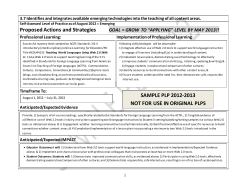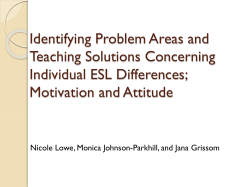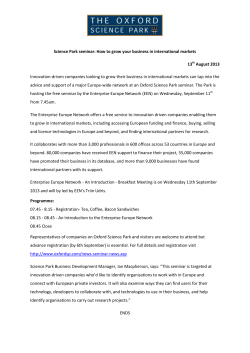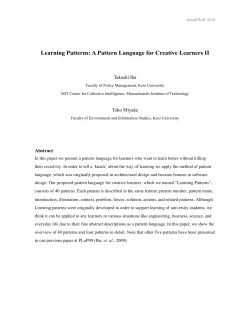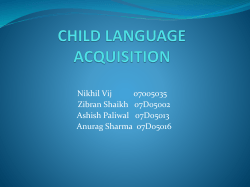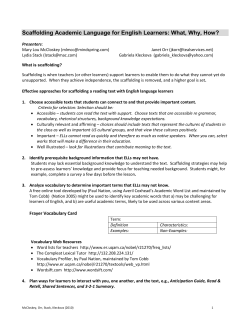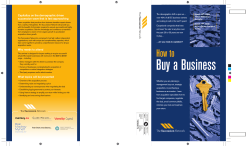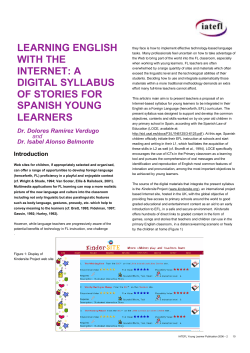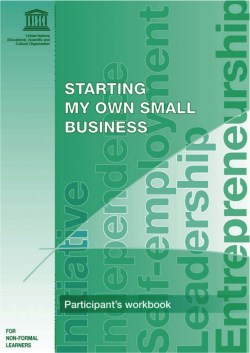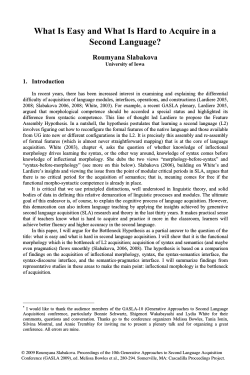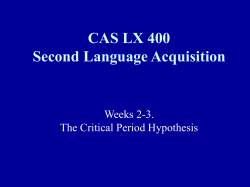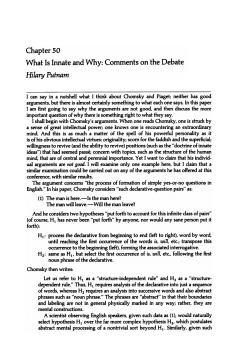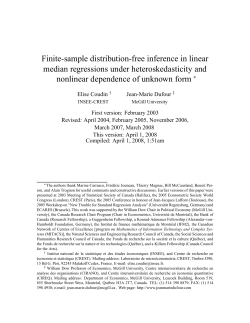
Document 224474
International Journal of Social Science and Humanity, Vol. 2, No. 6, November 2012 How to Use Gifted Tips of the Strategies of the First Language Acquisition to Promote Young L2 Learners of English in Classroom 1 Rasoo Hajizadeh and Saeed Mehrpour with no auditory problems. This varied perception creates an altered language pattern for the hearing-impaired child. Abstract—Learning a language is not as easy as it seems. There are many factors contributing to a child's language developmental process. The factors are presented in the child's life from the time of birth that assist the child learns to recognize certain speech patterns before learning to repeat words. The language acquisition device or LAD and primary linguistic data or PLD are very helpful factors in first language acquisition or L1 and second language learning or L2 as well. Some factors are external, while other factors are internal. C. Cognitive Processes Cognitive processes include the frequency of a language. A child who hears language at a higher frequency more often acquires language faster than children who hear the language at normal frequencies. Caregivers are wise to speak to children during normal daily activities to improve the frequency of language. (www.ehow.com/info.com). Index Terms—Acquisition device, external, internal of language development, speech patterns. D. Linguistics Linguistics factors are crucial to early language acquirement when a toddler uses a learned word to refer to a new object. Referring to a toy boat as a car is a common toddler linguistic occurrence. Linguistics also extends to word endings or variants on the same word. Because children attempt to learn a vast vocabulary, they try to assume a word's meaning by breaking the word apart and searching for context clues. For this reason, "running" becomes "run." Telling a toddler to stop running translates simply to "run." Many caregivers understand telling a toddler to stop an activity usually results in the opposite behavior, and this is partly due to the toddler's limited linguistic ability Bavin (2009). By the way, the language acquisition device or LAD as it is better known is theoretically a device or organ in the brain that helps assimilate language and its varying complexities. It was first proposed by Noam Chomsky to explain the seeming ease at which supports the children to pick up language with minimal input and almost no formal training. The LAD is a concept of the nativists theory of language. According to nativism there are certain abilities that are inherent in a human being. Language is supposed to be one of those skills (Lust 2006). During the time that it was proposed it was in direct contrast to B.F. Skinner’s theory of behavioral psychology, which emphasized the learning of a language to be based on the principles of imitation and classic operant conditioning and gave minimum importance to the biological or innate aspects that may be present. In 1965 Chomsky set out to understand the way children acquire language. The acquisition takes place with minimal input (primary linguistic data – PLD), incorrectly used words (parents will frequently use short, partial sentences often spoken in a totally different way) and no particular structure to the sentences being spoken. To answer these problems Chomsky postulated the following: I. INTRODUCTION The external and internal factors which are influential in learning L2 work together to produce vocabulary and speech patterns and are almost one-of-a-kind to each child for learning L1 and with some modification as young learners for learning L2 ( Bavin, 2009). The seminal propositions are such as genetics, social, perceptual, cognitive processes, conceptual understanding and linguistic factors that are decisive for learning L1 and L2 with the role of experienced teachers explained below. A. Gnetic Structure Scientists know language development is linked to genetic structure. Genetics' relation to language is an ongoing study; however, all scientists are interested in specific genetic combination which influences language. As mentioned by (Bavin, 2009) the genetic data strongly suggest that humans are wired to learn language. Toddlers hear the adults around them speaking every day. The language patterns chosen by a child and the use of speech are influenced by what the child hears. Children pay close attention to their caregivers because they are still very codependent and rely on caregivers for many needs. While a caregiver speaks, children listen. Children often repeat word patterns, accents and sentence structure based on what they hear (ibid). B. Perceptual Factor A child's perception, or understanding, of the spoken word supports his language development. A child who has issues hearing perceives language is differently from a child Manuscript received September 5, 2012; revised October 23, 2012. Rasool Hajizadeh is with Islamic Azad University, Firoozabad Branch, Iran (e-mail: Hajizadeh_14@yahoo.com) Saeed Mehrpour is with Shiraz University, Iran. DOI: 10.7763/IJSSH.2012.V2.156 1) 2) 501 There must be a method of understanding input signals There must be a method of presenting the structural International Journal of Social Science and Humanity, Vol. 2, No. 6, November 2012 3) 4) information about them The child already knows the rules and the structure of human language The child already knows how to apply these rules and structures with respect to each sentence in class-room. Teachers need to establish a classroom that promotes learning with a framework of attitudes and values. To acquire this, teachers must encourage their young learners by giving them the following attitudes and value as very precious tips in order to advance learning for all kinds of learners feasible. They must strongly use attitudes and values that do not limit learning, the sorts of attitudes and values which do not discourage our students’ learning. Teachers must put emphasize only on positive points that all students are able to learn to achieve at a high level. These can improve their area of weaknesses. Students must realize that there are many ways to learn any field of knowledge. There are also several advantages to thinking in different ways to succeed. Teachers should also familiarize students with language learning strategies (LLSs) that Rigney (1978) explained as often-conscious steps and behaviour used by learners to add up acquisition. LLSs are further elaborated by Oxford (1992) as: specific action, behaviours, steps or techniques that learners intentionally apply to make their progress in developing L2 skills. Utilizing these strategies by young learners make them able to facilitate internalization, storage, retrieval and use in a new language better and faster. LLSs are considered as tools for the self-directed involvement indispensable for developing communicative ability. In a similar manner, White (1995) describes LLSs as “the operations or processes which learners deploy to learn target language” (p.210). The teachers of L2 need to work hard to make very tangible and understandable as well as comprehensible relations among first language approaches such as LAD and PLD to L2 such as LLSs by applying the following educational tips in order to get the best results of L2 learning and teaching. All teachers should use the following tips to obtain the best results of L2 teaching and learning All of the above allow the child to select the appropriate structures and rules to the primary linguistic data (PLD) (About. com).Using these observations; the basis for LAD was defined by Chomsky. According to Chomsky LAD is supposed to progress through the following stages: 1) 2) 3) 4) LAD searches within the language structures and selects the various possible grammar that is compatible with the PLD LAD tests for compatibility, on the basis of the known implications of each grammatical structure for the sentences One grammar is selected as compatible with the PLD The grammar is used to interpret the input sentences. This has the capacity to represent structural information and applying grammar to the sentences ( Bavin, 2009). II. DISCUSSION Through this process of language acquisition a child knows a lot more about the language features than what has been learned in the classic sense (ibid). As an experienced teacher of English, I realized that features such as phonological, syntactic and semantic – are the primitive, elemental units that make up the lexical items of every language, and the differences between languages are due to differences among these features. Features can be bundled together onto functional categories in different, languagespecific ways, and even differently for different clause types within the same language (Oxford, 2002). It is thus the task of the language acquirer to distinguish these specific configurations of features from the properties and placement of particular lexical items present in the linguistic input. It seems that the centrality of the role of features is located at the heart of recent Chomskyan syntactic theory and within this theory at the heart of language variation. Therefore, any study of language acquisition done within this framework is now a study of the acquisition of features. So the role of English teachers is very divisive to combine these features in teaching that the learners do not feel that they are learning a language formally ( About. Com). To achieve this, it seems that using the Natural Approach to L2 teaching and learning based on the following hypotheses can be very persuasive. It implies that adults can get a second language much as they learn their first language through informal, implicit and subconscious learning. Language is acquired through comprehensible input. If an L2 learner is at a certain stage in language acquisition and he/she understands something that includes a structure at the next stage, this helps him/her to acquire that structure. The L2 learner will naturally substitute competence in L1 for competence in L2 ( Krashen and Terrell, 1983). Using the Natural Approach to L2 learning hypotheses and LAD progressions and the appropriate structures and rules of PLD enhance the young learners learnability of L2 A. Create a Classroom that Enhances Learning Meaningfully with Friendly Framework of Attitudes and Values Teachers need to give simple, clear, uncluttered visuals and handouts to students and give them enough time to copy from the blackboard. Teachers must give them easy assignment and ask and answer questions regularly. We need to be sure that questions, assignments, and directions are as clear as possible. We should give our students sufficient time to process their assignment, information, and questions. Take sufficient time to repeat, summarize explain, and answer questions willingly. We should keep these points in our mind. This notion is also proposed by Oliver and Bowler (2006) that teachers teach students to learn the subject and learn how to learn. B. Create and Send a Clear Message In order to have a useful and beneficial class, the teacher must go through the following stages. During the teaching, we must establish eye contact. Look at all students who must see our mouth, facial expressions, and gestures as we talk. We need to pronounce words clearly and correctly with enough volume and speak in a good manner. Teachers should use natural pauses in order to divide the material into phrases, and sentences in logical chunks. We must try so hard to be clear and direct but not simplistic. 502 International Journal of Social Science and Humanity, Vol. 2, No. 6, November 2012 C. Apply Multisensory Teaching The multisensory teaching technology relates to the different usages and applications of many different ways of teaching and learning strategies that promote learning in a wide variety of steps. Teachers who are teaching using this method must present and practice information in ways that encourage active involve ements, usually using more than one modality. They must be sure that the presentations, discussions, handouts, activities, visuals and materials are completely focused, clear and well organized. And students can clearly be aware of their aim and goals and purposes. exploration of such questions will it eventually be possible to improve the quality of information that language assessment provide.” (www.ehow.com/info.com). H. Respect Students as Central Partners in Learning We as teachers must always try so hard in order to make our young learners to have a feeling of respect so that they think their classroom is designed to create a productive positive atmosphere for them and teachers must encourage them ( in groups or as an individual) to share their thoughts, successes, difficulties, and reactions in their study. They must be encouraged to make connections between what they are learning and their own lives. They should learn to incorporate their opinions and reactions and put their experience into assignment, discussion, as well as other activities (Oxford, 2002). D. Provide a Clear, Explicit Structure Teachers' duties in class are very significant. They have to provide opportunities for their students so that they learn the materials skillfully and meaningfully. In order to achieve these goals, we need to make organization of time, materials, classroom calendars, homework, and other important information in regular locations. We need to give them directions and assignments both orally and in written form wherever possible. III. CONCLUSION Besides the use of approaches such LAD and PLD and LLSs in first and second language learning as mentioned above, we as teachers of L2 must allow the young learners to use mnemonic strategies which help them link a new item with something known because mnemonic strategies will be the first step in learning vocabulary items and grammar rules. People with certain personalities and certain motivations perform better in L2 acquisition at a certain stage in language learning. Learners with high self steam and also with high degrees of self confidence will be able to acquire L2 faster and more meaningfully. E. Provide Frequent Assignments and Meaningful Feedback In this respect, teachers must provide regular assignments which will provide the opportunity to review and synthesize information and can deepen language awareness for young university learners. Assessment and evaluations are components that Brown (1996) and Alderson (1985) consider as the focus of research in the field of Testing English as foreign or second language. We need to make the assessment for each assignment as explicit, fair, and meaningful as possible. We need to provide clear criteria for evaluation. We must to assess students frequently and give them weekly quizzes and assignment REFERENCES [1] F. Expose and Teach the Skills in an Informative Manner We teachers must try so hard to expose young learners to study skills which support success, such as active listening, reading skills, asking questions, note taking and, summarizing, how to use the text booked or be able to do time management. We never make assumptions about what students know. Learning channels and strategies are operations employed by the young learners to aid acquisition, storage, retrieval and use of information, and specific actions are taken by the learner to make learning easier, faster, more enjoyable, more self- directed, more effective and more transferable to new situations (Oxford, 1996). [2] [3] [4] [5] [6] [7] [8] [9] [10] G. Always Offer Flexible Alternative and Involve Students in the Learning Process It is very useful if we always offer our young learners multiple kinds of assignments and tests. We must permanently evaluate them with a range of ways to learn and to express their understanding. We should give them the gift of time, de-emphasize the role of time and speed in assignment and test As Brindley (2002) points out “we need to find out more about the ways in which tests and other assessments are used. Only through the systematic [11] [12] [13] [14] [15] [16] 503 J. C. Alderson, Lancaster Practical Paper in English Language Education, Evaluation, Oxford: Pergamoned, vol. 6, 1985. E. L. Bavin, The Cambridge handbook of child Language Cambridge, Cambridge University Press, 2009. G. Brindley, The Cambridge Guide to Teaching English to Speakers of Other Languages, Cambridge University Press, 2001. J. D. Brown, Testing in Language Programs, Upper Saddle River, NJ: Prentice Hall Regents, 1996. N. Chomsky, Aspect of the theory of syntax, Cambridge, Mass. MIT Press, 1965. S. D. Krashen and T. D. Terrell, The Natural Approach, Hayway, CA: The Alemany Press, 1983. B. Lust, Child Language Acquisition and Growth, Cambridge University Press, 2006. Oliver and Bowler, Learning to Learn, London: Simmon and Schuster, 2006. R. L. Oxford, Language Learning Strategies around the World: Cross-cultural perspectives, Monoa, HI: University of Hawai’i press, 2002. R. L. Oxford, Language Learning Strategies around the World: Cross-Cultural Perspectives, Manoa, HL: University of Hawai’i Press, 1996. R. L. Oxford, “Language learning strategies in a nutshell,” Update and ESL suggestions,” TESOL Journal, vol. 2, pp. 18-22, 1996 R. L. Oxford, The Cambridge guide to Teaching English to speakers of Other Languages, Cambridge University Press, 2002. J. W. Rigney, What the good language learner, can teach us. TESOL Quarterly, vol. 9, no. 1, pp. 41-51. 1978. B. F. Skinner, Science and Human Behavior, New York: Macmillan,1953. C. White, “Anatomy and strategy use in distance foreign language learning,” Research findings System, vol. 23, no. 2, pp. 207-221. 1995. Read more: Influences on Language Development e how. [Online]. Available: http://www.ehow.com/info_7946828_influences-languagedevelopment.html#ixzz1zRhAcoTr International Journal of Social Science and Humanity, Vol. 2, No. 6, November 2012 Rasool Hajizadeh received his M.A. in Linguistics in 1993 from The Pennsylvania State University, B.A. from Shiraz University in 1988. His publications include English Textbook for students of chemistry, and articles including Whole language Theory, Stylistic Variation in English, Simulation and Gaming Theory, The Survey of Positive aspects and Negative Aspects of Anxiety among Students in Firooz Abad University and Sleep Learning Approaches. He is currently an English Instructor in Firooz Abad and Shiraz Azad Universities and a Ph.D. Candidate at Shiraz University, Iran. [17] Read more: Influences on Language Development e how. [Online]. Available: http://www.ehow.com/info_7946828_influences-languagedevelopment.html#ixzz1zRgqtONk [18] Internet addresses: Read more: Influences on Language Development 2.e how. [Online]. Available: http://www.ehow.com/info_7946828_influences-languagedevelopment.html#ixzz1zRgqtONk 3. & 4. 504
© Copyright 2025
